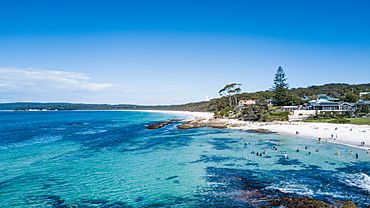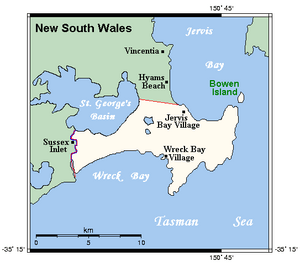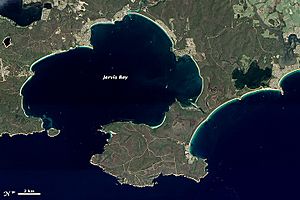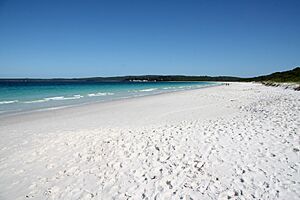Hyams Beach, New South Wales facts for kids
Quick facts for kids Hyams BeachNew South Wales |
|||||||||||||||
|---|---|---|---|---|---|---|---|---|---|---|---|---|---|---|---|

Hyams Beach, Jervis Bay NSW
|
|||||||||||||||
| Population | 112 (2016 census) | ||||||||||||||
| Postcode(s) | 2540 | ||||||||||||||
| LGA(s) | City of Shoalhaven | ||||||||||||||
| Region | South Coast | ||||||||||||||
| County | St Vincent | ||||||||||||||
| Parish | Bherwerre | ||||||||||||||
| State electorate(s) | South Coast | ||||||||||||||
| Federal Division(s) | Gilmore | ||||||||||||||
|
|||||||||||||||
Hyams Beach is a small seaside village in New South Wales, Australia. It's located on the beautiful shores of Jervis Bay. In 2016, about 112 people lived there.
This village is about 180 kilometers south of Sydney. It's famous for its amazing beach, which has clear, turquoise-colored water and super fine, squeaky white sand. This sand is made of pure quartz! Hyams Beach is right in the middle of two other beaches: Chinaman's Beach to the north and Seaman's Beach (also called "Sailors Beach") to the south.
Contents
Exploring Hyams Beach and Its Surroundings

The beaches at Hyams Beach face east, looking out over Jervis Bay and Point Perpendicular towards the Pacific Ocean. The village is surrounded by nature. To the north, you'll find Jervis Bay National Park, and to the south, there's Booderee National Park and Botanic Gardens. This means Hyams Beach feels like a natural bushland area, full of native plants, animals, and birds. You can also explore the Jervis Bay Marine Park and nearby trails and forests.
There's a popular idea that Hyams Beach has the whitest sand in Australia. This idea started from a sign at the local store. However, it's actually a misconception. Australia's truly whitest beaches are Lucky Bay and Hellfire Bay in Western Australia, and Tallebudgera Creek Beach in Queensland.
Amazing Wildlife
The animals and birds you'll see here are typical for the coastal Shoalhaven area.
Birds You Might Spot
More than 140 types of birds have been seen around Hyams Beach. On the beach itself or flying over the bay, you might see:
- Silver gull
- Crested tern
- White-bellied sea eagle
- Australian pied oystercatcher
- Australasian gannet
- Sooty oystercatcher
- White-faced heron
- Masked lapwing
- Little pied cormorant
- Little black cormorant
The bushland behind Hyams Beach is also home to one of the largest groups of the endangered Eastern bristlebird.
Fun Things to Do and See
Most places to stay in Hyams Beach are holiday homes, from simple cottages to fancy beachfront houses. Some even offer bed and breakfast. There's also one café and store in the village.
Hyams Beach is a great place for tourists. You can enjoy bush and coastal walks that give you amazing views of the bay, the National Park, and the ocean. The ocean is perfect for fishing, swimming, snorkelling, diving, and even whale watching. The surrounding bushland is full of native animals and many different bird species.
Tourism has really helped Hyams Beach become a popular spot in New South Wales. Because so many tourists visit, a new freeway was finished in 2017. It cost $580 million and makes the 190-kilometer drive from Sydney much easier. Hyams Beach's super white sand has even been featured on the back of Sydney buses as part of a tourism campaign! The village has also appeared in TV ads and has a big presence on social media, thanks to publicity from Lonely Planet.
Protecting Our Beautiful Beach
The popularity of Hyams Beach can sometimes cause problems. The village, which usually has only 112 people, can quickly fill up with 4,000 visitors on busy summer evenings. This leads to streets packed with traffic and tourists sometimes littering on the beach.
Local residents have asked the council to help with these issues. Since there's only one road in and out of the village, too many cars can make it impossible for emergency vehicles to get through. It also makes it hard for people to evacuate if there's a bushfire. To help with this, the council now closes the village once its 450 street parking spaces are full. A local bush care group is also working hard to replant the dunes, which have been damaged by tourists looking for shade or illegal camping spots.
Who Lives in Hyams Beach

The 2016 Australian census showed that Hyams Beach is a well-off area. About 20% of its residents earned more than $3,000 a week. A high number, 90%, owned their homes, and 93% of houses had three or four bedrooms.
Here are some other interesting facts from the census:
- Most people (80.4%) living in Hyams Beach were born in Australia. Others came from England (8.8%), South Africa (3.9%), and New Zealand (2.9%).
- The most common backgrounds were English (31.7%), Scottish (19.0%), Irish (18.3%), Australian (16.2%), and German (5.6%).
- For religion, many people said they had no religion (30.1%). Others were Anglican (25.2%), Catholic (20.4%), or Jehovah's Witnesses (5.8%).
- Almost everyone (96.1%) spoke only English at home. A small number (3.9%) spoke Afrikaans.
- Most adults (70.5%) were married.
- All the homes were separate houses.
A Look Back at History
The land where Hyams Beach is today traditionally belongs to a group of the Yuin people. Early settlers called them 'the Jervis Bay tribe'. These people are also known as the Wandandian people and spoke Dharamba, a dialect of the Dhurga language.
Hyams Beach is named after Michael Hyam, who was given 41 acres of land here in 1859.
Later, a developer named Henry Halloran bought a lot of land around Jervis Bay. Around 1916, he started selling land at Hyams Beach. This area was next to his much bigger plan for 'Pacific City', which never actually happened. In the mid-1920s, Halloran was building holiday cottages at Hyams Beach for people to rent. Even as late as 1938, the village still didn't have electricity.
Images for kids









